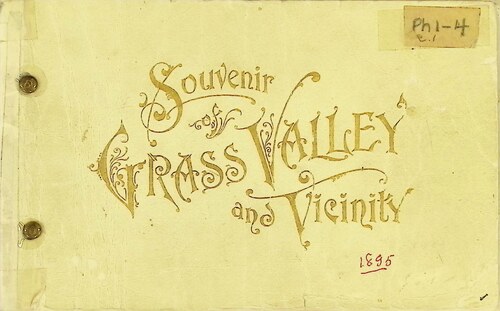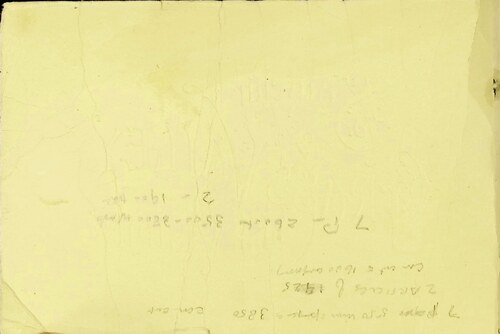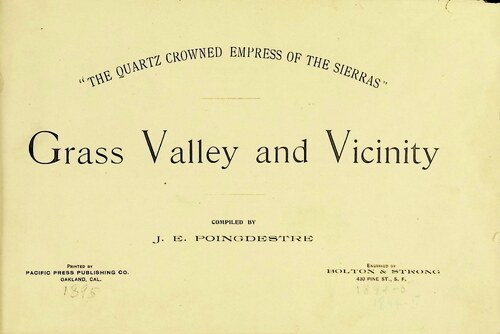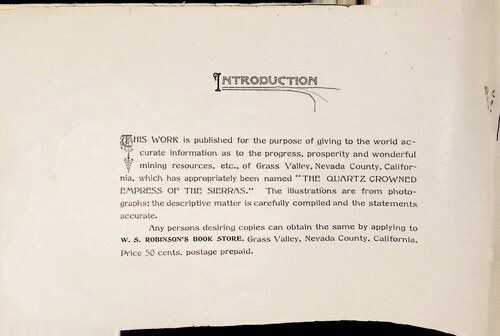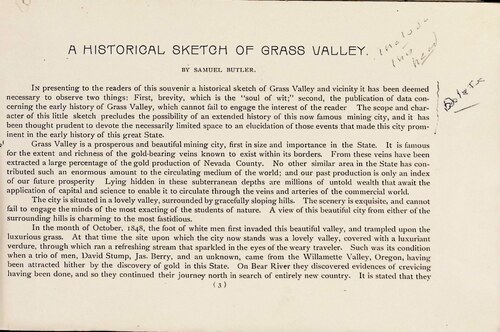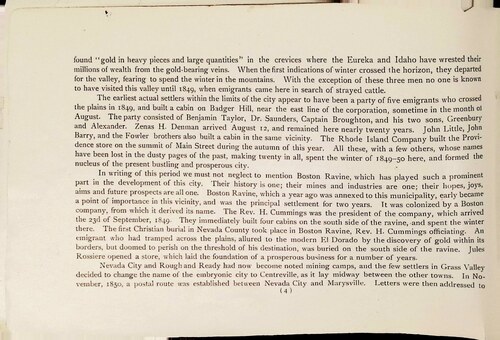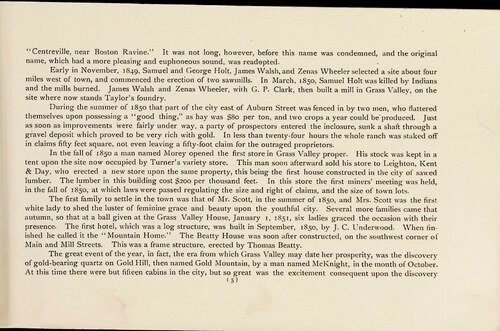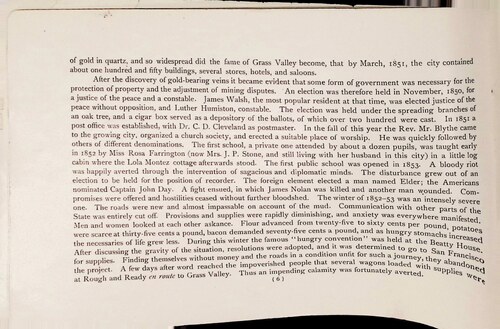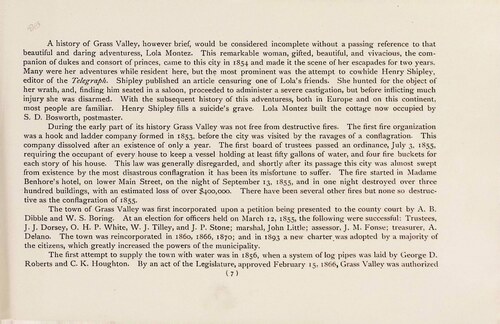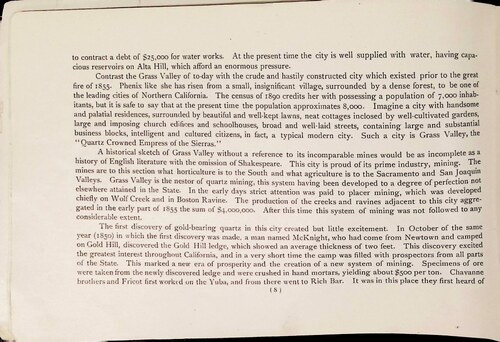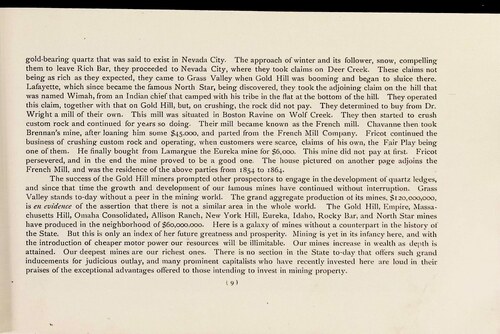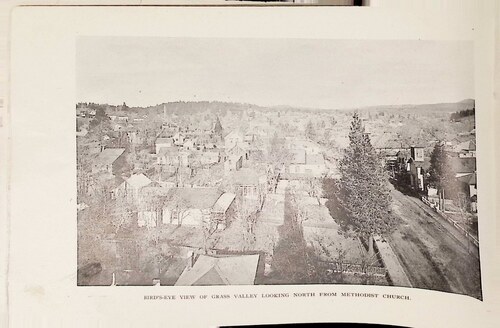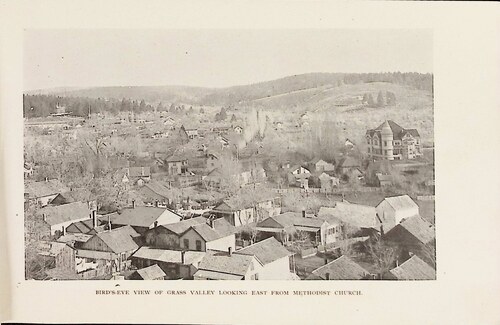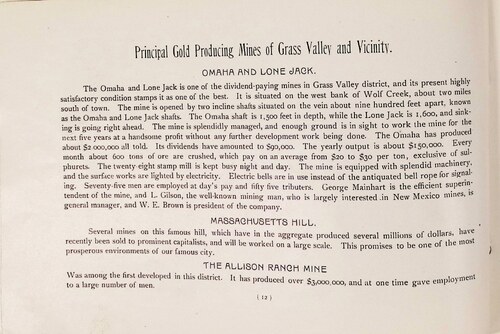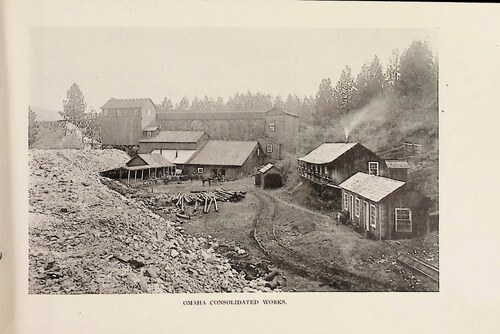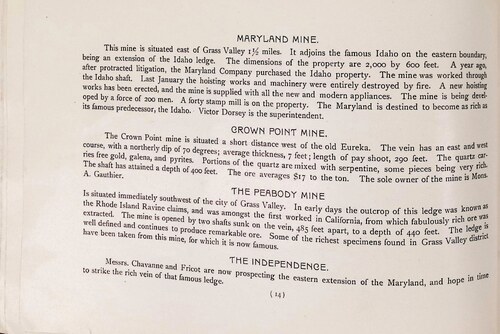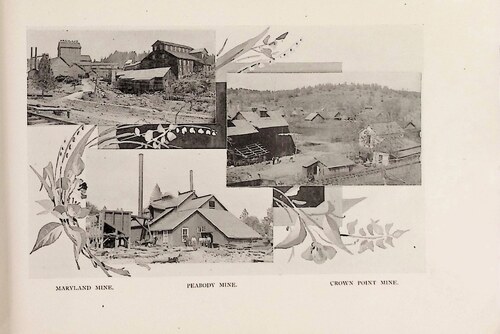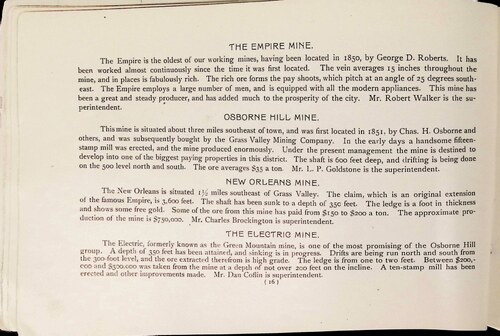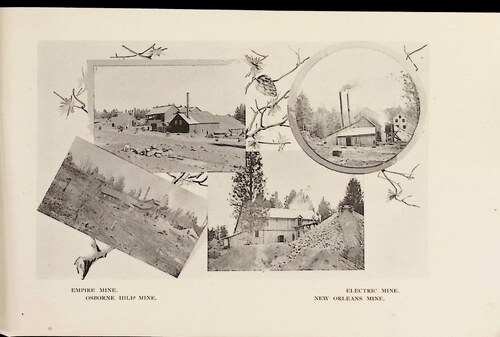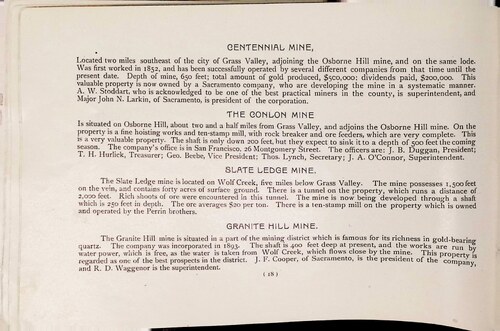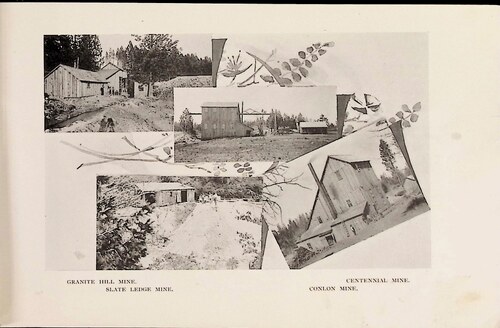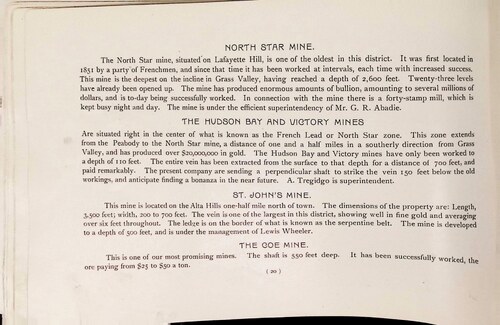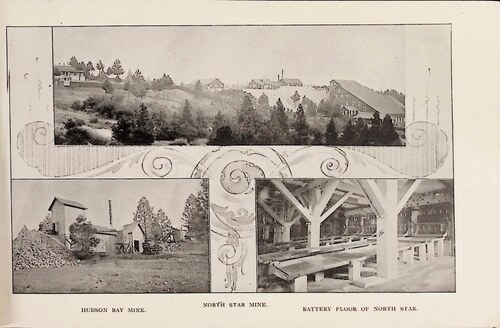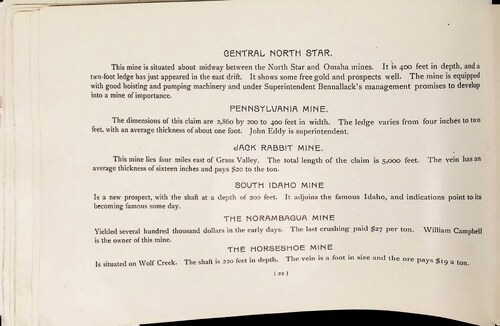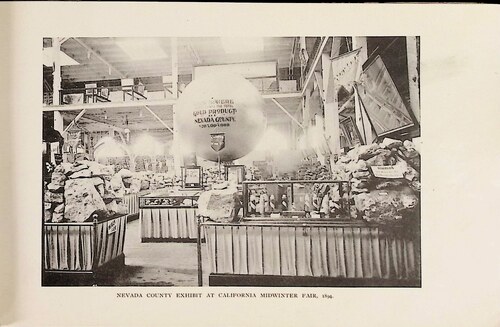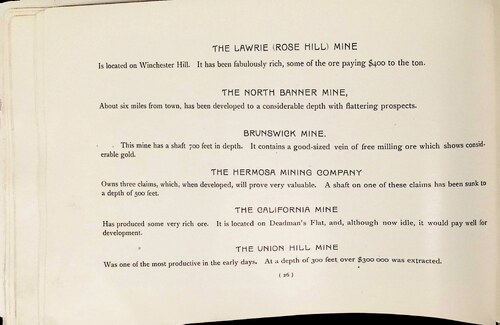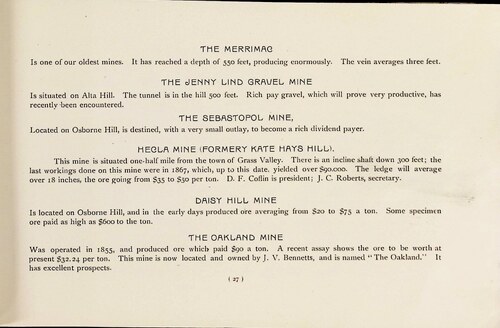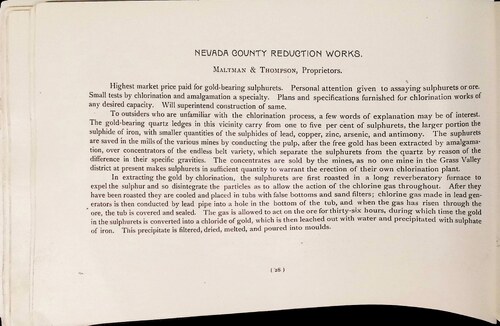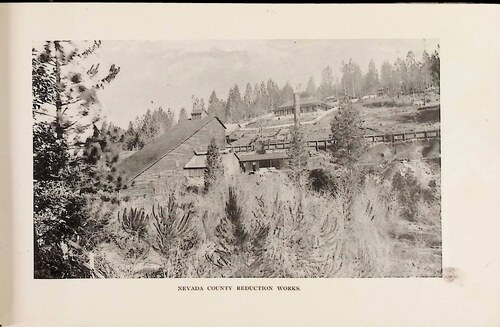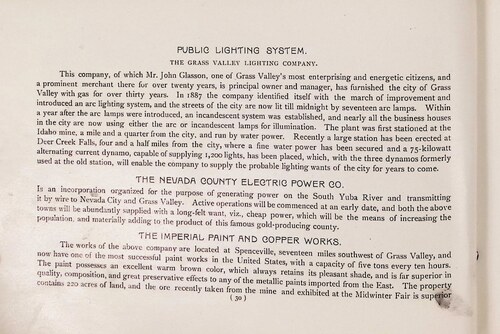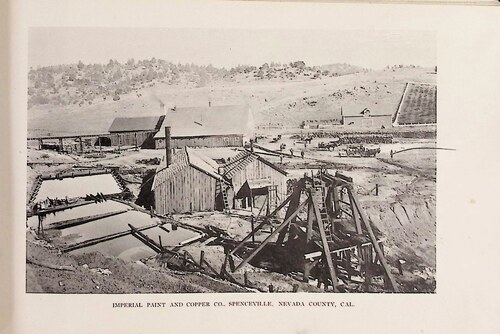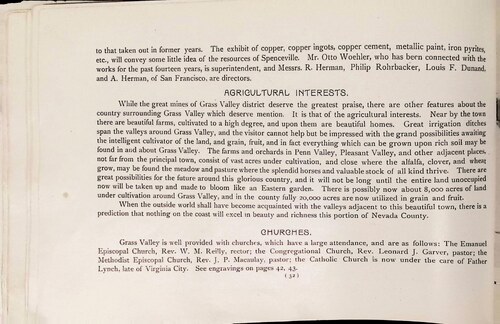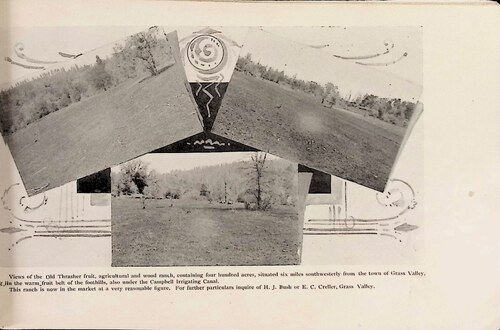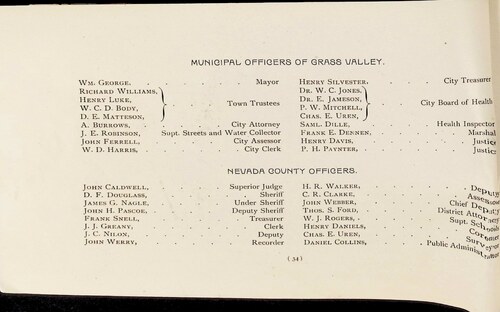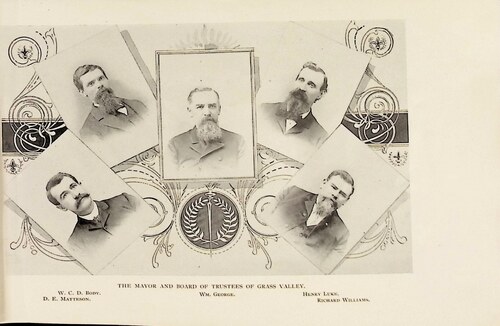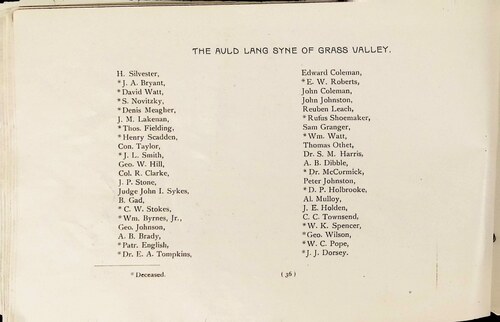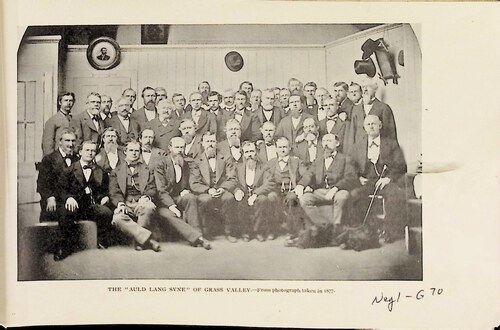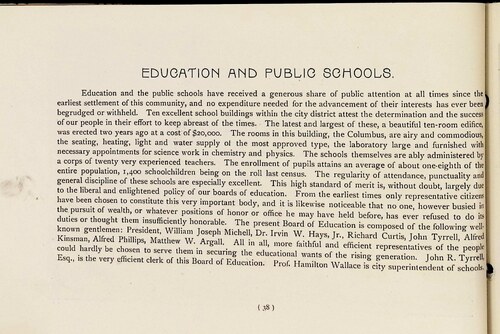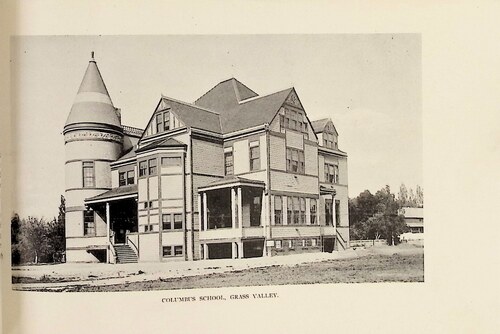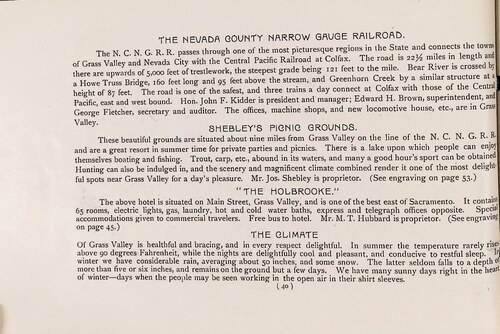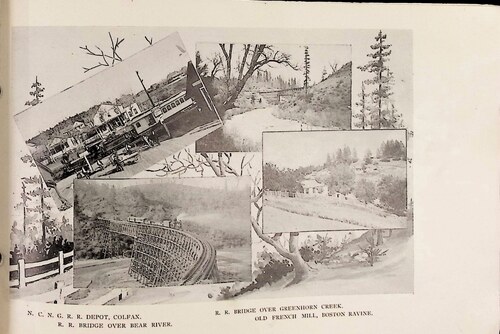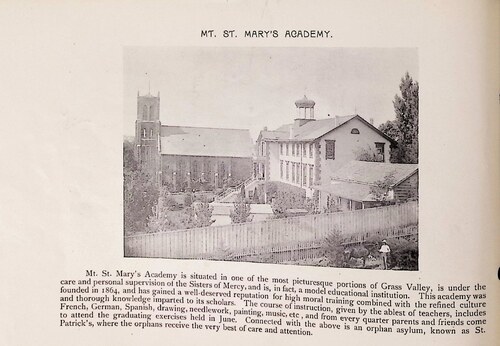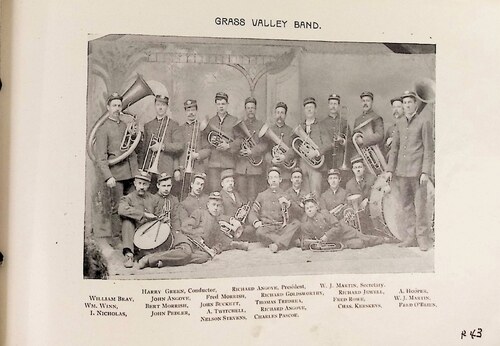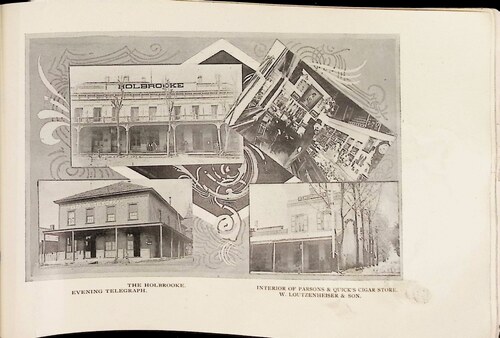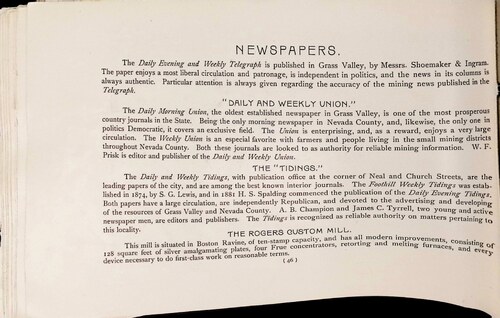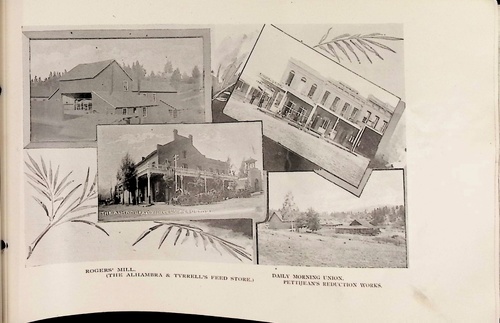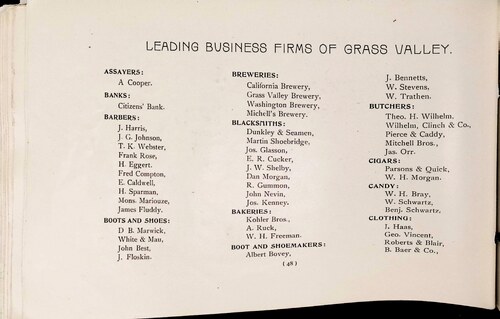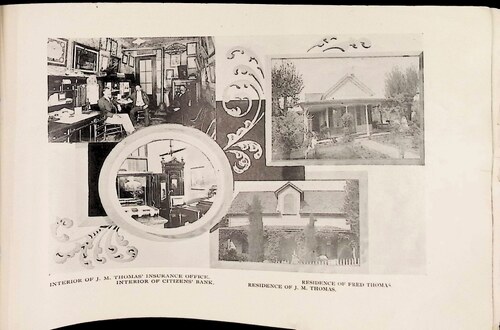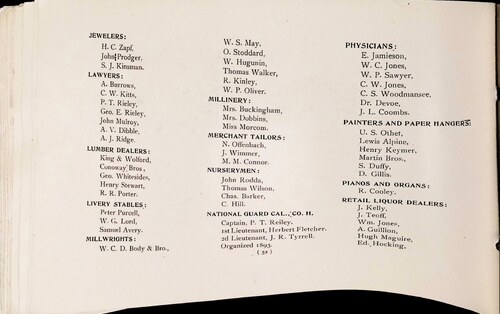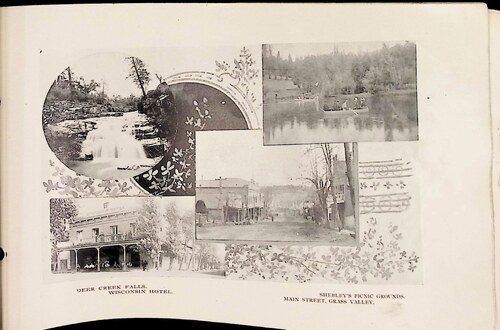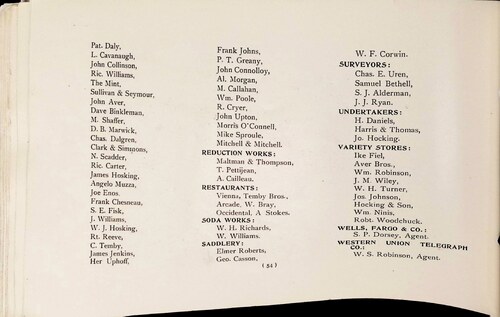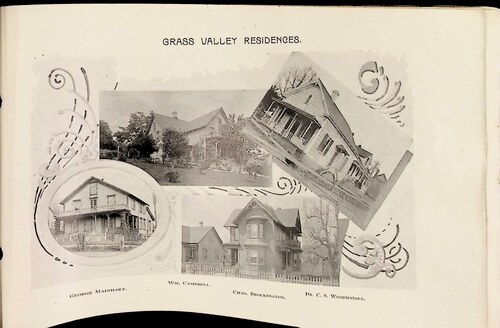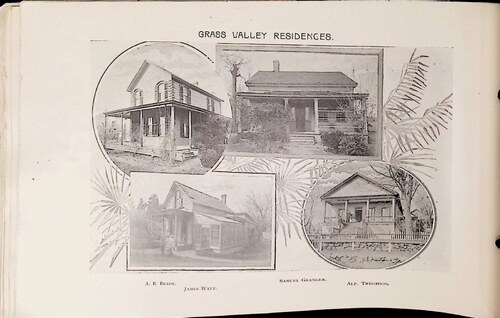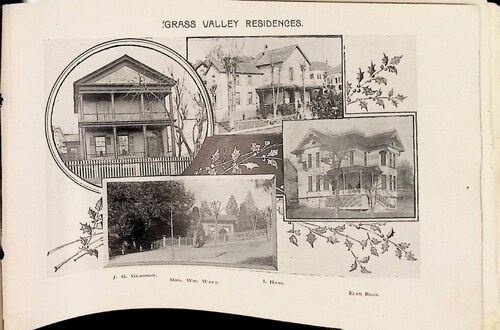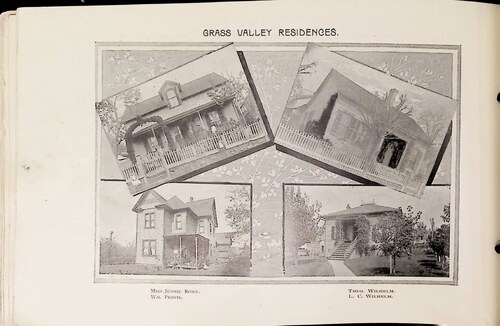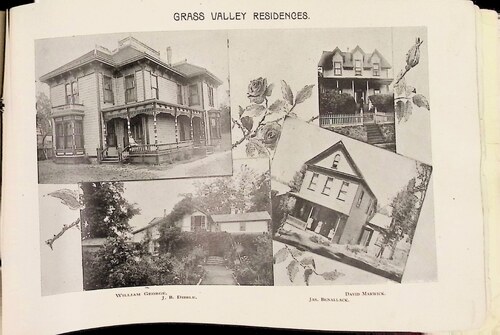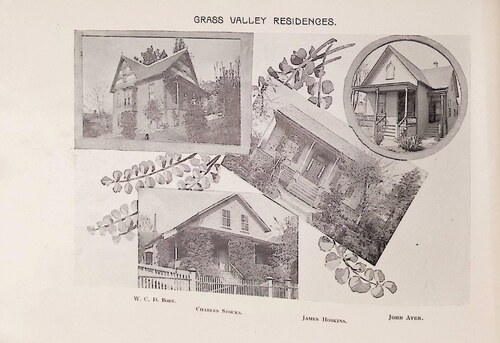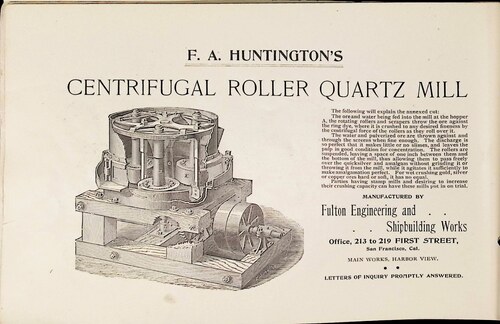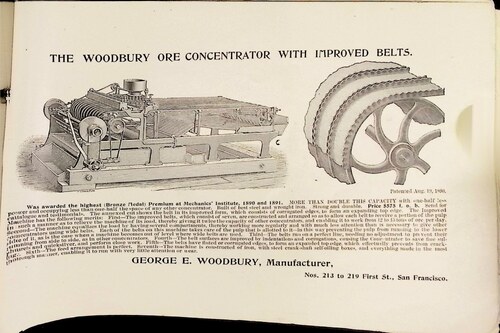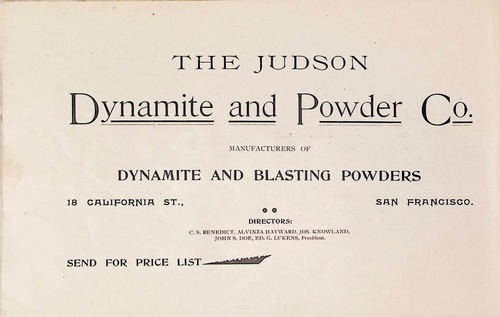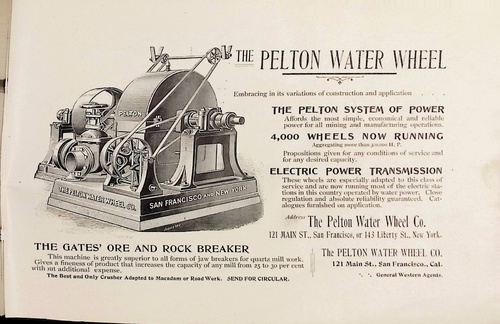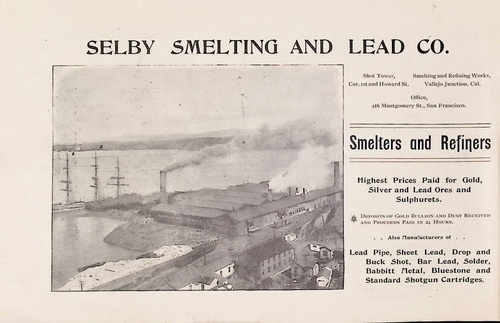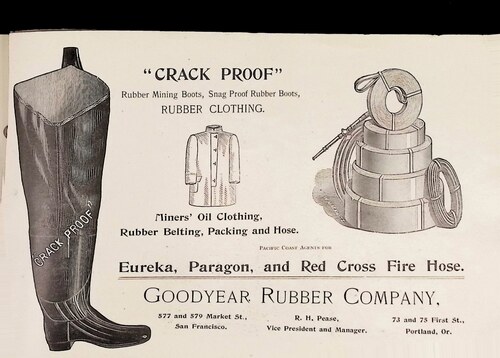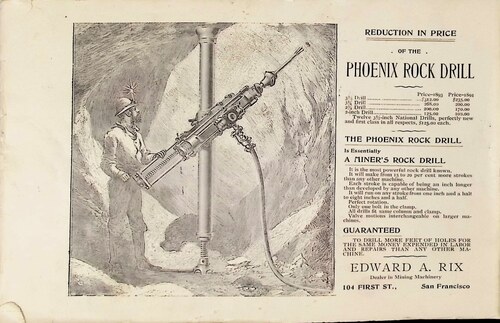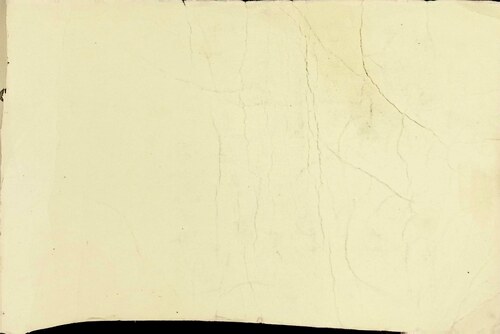Enter a name, company, place or keywords to search across this item. Then click "Search" (or hit Enter).
Collection: Directories and Documents > Pamphlets
Grass Valley and Vicinity (PH 1-4)(Circa 1895) (67 pages)
Grass Valley and Vicinity -- though dubbed a "souvenir" on its cover, and classified as a pamphlet by Searls Historical Library, is more like a booklet. Either way, it's a mid-1890s attempt to publicize Grass Valley as a center of quartz mining. And while clearly a work undertaken to boost investment in local mines, it was not given away but sold for 50 cents including postage.
Souvenir of Grass Valley and Vicinity [cover]
"Quartz Crowned Empress of the Sierras" [title page]
Grass Valley and Vicinity [title page]
Compiled by J. E. [John Edmund] Poingdestre
Printed by Pacific Press Publishing Co., Oakland
Engraved by Bolton & Strong, S. F.
Undated, circa 1895
60 plus 8 pages
The 60 pages of the main text of Grass Valley and Vicinity include 27 full page photographs of mines, people, and residences, several of them collages. The feature article, "A Historical Sketch of Grass Valley", is by Samuel Butler (pages 3-9).
The back matter consists of 8 pages of ads from San Francisco firms selling mining machinery. This, and the lack of local ads, suggest whose interests were also served by its publication. The sellers of mining equipment were as anxious to boost Grass Valley's mining operations as its local businessmen.
The booklet begins with a "historical sketch" of Grass Valley by Samuel Butler. He introduces with sketch with a long explanation of his intent that the sketch be brief and present historical data of interest to the reader. The sketch itself begins with the second paragraph, which sets the booklet's boosteristic invest-in-us tone (p3).
Grass Valley is a prosperous and beautiful mining city, first in size and importance in the State. It is famous for the extent and richness of the gold-bearing veins known to exist within its borders. From these veins have been extracted a large percentage of the gold production of Nevada County. No other similar area in the State has contributed such an enormous amount to the circulating medium of the world; and our past production is only an index of our future prosperity[.] Lying hidden in these subterranean depths are millions of untold wealth that await the application of capital and science to enable it to circulate through the veins and arteries of the commercial world.
Most of Grass Valley and Vicinity is reproduced in David and Ardis Comstock's 1895 Pictorial History of Nevada County (2000), which see for a review.
John Edmund Poingdestre (1854-1931), an Englishman-turned-American, who managed the Grass Valley office of the Nevada County Gas and Electric Company, was also the compiler of Nevada City and its Resources Mining Interests and Business Firms, 1893 (1893) and Nevada County Mining and Business Directory, 1895 (1895). These publications were also printed by Pacific Press Publishing in Oakland. See a sketch of Poingdestre's life in the review of his 1895 county directory.
Samuel Butler (1865-1920), a self-educated local miner turned journalist, editor, and political activist, also wrote the sketches of Nevada County, Nevada City, and Grass Valley for Poingdestre's 1895 county directory. He was born in England in July 1865, emigrated to the United States in 1887, and had naturalized by the 1900 census, which shows him living on Auburn street in Grass Valley as a 34-year-old miner. He wrote for, and was briefly an editor of, The Tidings in Grass Valley, which had daily and weekly editions, and the Miner-Transcript in Nevada City.
In 1902, when Butler was the head of the local miners union, he supported the candidacy of Franklin K. Lane (1864-1921) for governor of California. Lane lost, but when he became the Secretary of the Interior under President Wilson, in 1913, he appointed Butler to run the Department of the Interior's Receiver of the Land office in Sacramento. At the time, Butler was the editor of The Marysville Appeal. He died in Sacramento from pneumonia concomitant with influenza and kidney problems on 22 February 1920 at age 54. He was a native of Cornwall, and left no relatives in America, according to an obituary (The Morning Union, Tuesday, 24 February 1920, page 8).
Souvenir of Grass Valley and Vicinity [cover]
"Quartz Crowned Empress of the Sierras" [title page]
Grass Valley and Vicinity [title page]
Compiled by J. E. [John Edmund] Poingdestre
Printed by Pacific Press Publishing Co., Oakland
Engraved by Bolton & Strong, S. F.
Undated, circa 1895
60 plus 8 pages
The 60 pages of the main text of Grass Valley and Vicinity include 27 full page photographs of mines, people, and residences, several of them collages. The feature article, "A Historical Sketch of Grass Valley", is by Samuel Butler (pages 3-9).
The back matter consists of 8 pages of ads from San Francisco firms selling mining machinery. This, and the lack of local ads, suggest whose interests were also served by its publication. The sellers of mining equipment were as anxious to boost Grass Valley's mining operations as its local businessmen.
The booklet begins with a "historical sketch" of Grass Valley by Samuel Butler. He introduces with sketch with a long explanation of his intent that the sketch be brief and present historical data of interest to the reader. The sketch itself begins with the second paragraph, which sets the booklet's boosteristic invest-in-us tone (p3).
Grass Valley is a prosperous and beautiful mining city, first in size and importance in the State. It is famous for the extent and richness of the gold-bearing veins known to exist within its borders. From these veins have been extracted a large percentage of the gold production of Nevada County. No other similar area in the State has contributed such an enormous amount to the circulating medium of the world; and our past production is only an index of our future prosperity[.] Lying hidden in these subterranean depths are millions of untold wealth that await the application of capital and science to enable it to circulate through the veins and arteries of the commercial world.
Most of Grass Valley and Vicinity is reproduced in David and Ardis Comstock's 1895 Pictorial History of Nevada County (2000), which see for a review.
John Edmund Poingdestre (1854-1931), an Englishman-turned-American, who managed the Grass Valley office of the Nevada County Gas and Electric Company, was also the compiler of Nevada City and its Resources Mining Interests and Business Firms, 1893 (1893) and Nevada County Mining and Business Directory, 1895 (1895). These publications were also printed by Pacific Press Publishing in Oakland. See a sketch of Poingdestre's life in the review of his 1895 county directory.
Samuel Butler (1865-1920), a self-educated local miner turned journalist, editor, and political activist, also wrote the sketches of Nevada County, Nevada City, and Grass Valley for Poingdestre's 1895 county directory. He was born in England in July 1865, emigrated to the United States in 1887, and had naturalized by the 1900 census, which shows him living on Auburn street in Grass Valley as a 34-year-old miner. He wrote for, and was briefly an editor of, The Tidings in Grass Valley, which had daily and weekly editions, and the Miner-Transcript in Nevada City.
In 1902, when Butler was the head of the local miners union, he supported the candidacy of Franklin K. Lane (1864-1921) for governor of California. Lane lost, but when he became the Secretary of the Interior under President Wilson, in 1913, he appointed Butler to run the Department of the Interior's Receiver of the Land office in Sacramento. At the time, Butler was the editor of The Marysville Appeal. He died in Sacramento from pneumonia concomitant with influenza and kidney problems on 22 February 1920 at age 54. He was a native of Cornwall, and left no relatives in America, according to an obituary (The Morning Union, Tuesday, 24 February 1920, page 8).
Catalog #: PH 1-4
Author: J. E. Poingdestre, compiler
Publisher: Pacific Press Publishing Co. (Oakland, printer)
Published: Circa 1895
Subjects: Grass Valley, History, Mines, Contemporary Conditions, 1895
Related Items:
Author: J. E. Poingdestre, compiler
Publisher: Pacific Press Publishing Co. (Oakland, printer)
Published: Circa 1895
Subjects: Grass Valley, History, Mines, Contemporary Conditions, 1895
Related Items:
- Directories > Nevada County Mining and Business Directory, 1895 (650.025.POI)(1895)
- 1895 Pictorial History of Nevada County, California (979.437 COM (622.342 NEV, PH 1-4))(2000)
- Pamphlets > Nevada City and its Resources Mining Interests and Business Firms, 1893 (PH 1-2)(1893)
Zoom Out
Zoom In (Please allow time for high-res images to load)
Zoom: 100%




